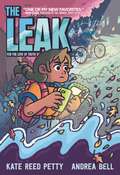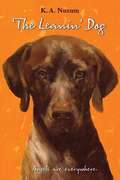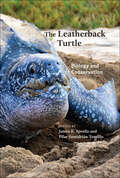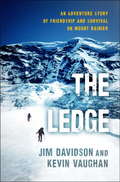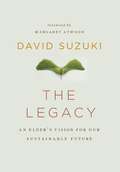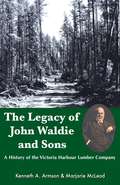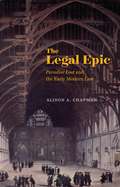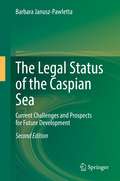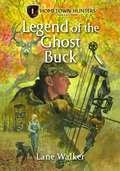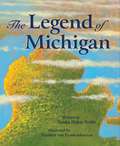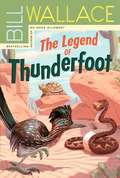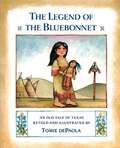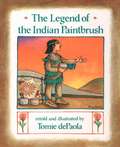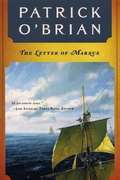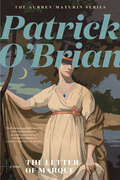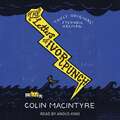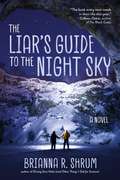- Table View
- List View
The Leak
by Kate Reed PettyIn this compelling middle-grade graphic novel The Leak, Ruth, a young journalist, is determined to uncover a secret that threatens her town.Ruth Keller is brash and precocious; she argues with her dentist, her parents, and her teachers. So, when she discovers a strange black slime in the man-made lake of her suburban neighborhood, she decides to investigate. Fortified by the encouragement of those around her, Ruth seeks the truth at all costs, even if it means taking on the rich local country club owner, who she believes is responsible for the pollution. Between the teasing of former friends, and a sudden viral spotlight, Ruth discovers how difficult it is for a journalist to take a stand for what's right in the face of critique and controversy. From writer Kate Reed Petty and illustrator Andrea Bell, comes a story about corruption, pollution, and freedom of the press, and the young journalist at the center of it all.
The Leanin' Dog
by K. A. NuzumMore than anything, Dessa Dean needed a friend. A friend to love and confide in, a friend with whom she could share her heart. <P><P>A friend who would delight in all the beauty and joy and fun of Christmas, only four days away. Hope had just about run out, but then... there came a scratchin' at the door and Dessa Dean's life was forever changed.
The Leasing of Federal Lands for Fossil Fuels Production (RFF Energy Policy Set)
by Stephen MacdonaldStephen McDonald offers a basic understanding of the goals and practices by which the federal government leases its fossil fuel resources and how these practices affect the economy. Originally published in 1979
The Leatherback Turtle: Biology and Conservation
by James R. Spotila Pilar Santidrián TomilloThe most comprehensive book ever written on leatherback sea turtles.Weighing as much as 2,000 pounds and reaching lengths of over seven feet, leatherback turtles are the world’s largest reptile. These unusual sea turtles have a thick, pliable shell that helps them to withstand great depths—they can swim more than one thousand meters below the surface in search of food. And what food source sustains these goliaths? Their diet consists almost exclusively of jellyfish, a meal they crisscross the oceans to find. Leatherbacks have been declining in recent decades, and some predict they will be gone by the end of this century. Why? Because of two primary factors: human redevelopment of nesting beaches and commercial fishing. There are only twenty-nine index beaches in the world where these turtles nest, and there is immense pressure to develop most of them into homes or resorts. At the same time, longline and gill net fisheries continue to overwhelm waters frequented by leatherbacks. In The Leatherback Turtle, James R. Spotila and Pilar Santidrián Tomillo bring together the world’s leading experts to produce a volume that reveals the biology of the leatherback while putting a spotlight on the conservation problems and solutions related to the species. The book leaves us with options: embark on the conservation strategy laid out within its pages and save one of nature’s most splendid creations, or watch yet another magnificent species disappear.
The Ledge
by Jim Davidson Kevin Vaughan"My eyes travel up the frozen walls. I figure it is eighty feet up to the sunlight. The walls above me climb up at about eighty degrees, then they go dead vertical, and then, higher up, they overhang. It is as if I am looking out from the belly of a beast, its jagged white teeth interlocking above me." In June 1992, best friends Jim Davidson and Mike Price stood triumphantly atop Washington's Mount Rainier, celebrating what they hoped would be the first of many milestones in their lives as passionate young mountaineers. Instead, their conquest gave way to catastrophe when a cave-in plunged them deep inside a glacial crevasse--the pitch-black, ice-walled hell that every climber's nightmares are made of.An avid adventurer from an early age, Davidson was already a seasoned climber at the time of the Rainier ascent, fully aware of the risks and hopelessly in love with the challenge. But in the blur of a harrowing free fall, he suddenly found himself challenged by nature's grandeur at its most unforgiving. Trapped on a narrow, unstable frozen ledge, deep below daylight and high above a yawning chasm, he would desperately battle crumbling ice and snow that threatened to bury him alive, while struggling in vain to save his fatally injured companion. And finally, with little equipment, no partner, and rapidly dwindling hope, he would have to make a fateful choice--between the certainty of a slow, lonely death or the seeming impossibility of climbing for his life.At once a heart-stopping adventure story, a heartfelt memoir of friendship, and a stirring meditation on fleeting mortality and immutable nature, The Ledge chronicles one man's transforming odyssey from the dizzying heights of elation and awe to the punishing depths of grief and hard-won wisdom. This book's visceral, lyrical prose sings the praises of the physical world's wonders, while searching the souls of those willing, for better or worse, to fully embrace it.From the Hardcover edition.
The Legacy
by Margaret Atwood David SuzukiIn this expanded version of an inspiring speech delivered in December 2009, David Suzuki reflects on how we got where we are today and presents his vision for a better future. In his living memory, Suzuki has witnessed cataclysmic changes in society and our relationship with the planet: the doubling of the world's population, our increased ecological footprint, and massive technological growth.Today we are in a state of crisis, and we must join together to respond to that crisis. If we do so, Suzuki envisions a future in which we understand that we are the Earth and live accordingly. All it takes is imagination and a determination to live within our, and the planet's, means. This book is the culmination of David Suzuki's amazing life and all of his knowledge, experience, and passion - it is his legacy.
The Legacy of John Waldie and Sons: A History of the Victoria Harbour Lumber Company
by Kenneth A. Armson Marjorie McleodAt the time of his death in 1907, John Waldie, founder of the Victoria Harbour Lumber Company, was identified as "the second largest lumber operator in Canada." A young Scottish immigrant who came to Wellington Square (now Burlington, Ontario) in 1842, he rose to prominence as a wealthy merchant and ship owner. In 1885 he entered the lumber business. Active in local and federal politics, and a friend of Sir Wilfrid Laurier, he invested capital in mills, people and forests.Local history and genealogical connections are part of the Waldie story, headquartered at Victoria Harbour in Simcoe County. Documentation of the forest that the company logged, their nature, amount and sizes of logs harvested with the descriptions of the forests as they are now, throws new light and shatters some of the current myths.This little-known story provides insights into days of rampant entrepreneurialism, the world of the lumber barons and the overall impact on our Ontario forests.
The Legacy of Nuclear Power
by Andrew BlowersNuclear energy leaves behind an infinitely dangerous legacy of radioactive wastes in places that are remote and polluted landscapes of risk. Four of these places - Hanford (USA) where the plutonium for the first atomic bombs was made, Sellafield, where the UK’s nuclear legacy is concentrated and controversial, La Hague the heart of the French nuclear industry, and Gorleben, the focal point of nuclear resistance in Germany - provide the narratives for this unique account of the legacy of nuclear power. The Legacy of Nuclear Power takes a historical and geographical perspective going back to the origins of these places and the ever changing relationship between local communities and the nuclear industry. The case studies are based on a variety of academic and policy sources and on conversations with a vast array of people over many years. Each story is mediated through an original theoretical framework focused on the concept of ‘peripheral communities’ developing through changing discourses of nuclear energy. This interdisciplinary book brings together social, political and ethical themes to produce a work that tells not just a story but also provides profound insights into how the nuclear legacy should be managed in the future. The book is designed to be enjoyed by academics, policy-makers and professionals interested in energy, environmental planning and politics and by a wider group of stakeholders and the public concerned about our nuclear legacy.
The Legal Aspects of Industrial Hygiene and Safety (Sustainable Improvements in Environment Safety and Health)
by Kurt W. DregerThe Legal Aspects of Industrial Hygiene and Safety explores various legal issues that are often encountered by Industrial Hygiene and Safety managers during their careers. A description is presented of the various legal concepts and processes that often arise in the IH/S practice, including tort, contract, and administrative law. The goal is to provide IH/S managers with sufficient knowledge to be able to incorporate legal risk analysis into everyday decision-making and policy development. This book will explore the legal issues that arise in IH/S practice and will be helpful to new IH/S managers as they progress in their careers. FEATURES Explores various legal issues that are often encountered by Industrial Hygiene and Safety managers during their careers Provides insight into the legal issues and processes to IH/S managers that are traditionally only available to attorneys Improves the IH/S managers' ability to communicate complex IH/S issues to in-house counsel Presents tools and knowledge to IH/S managers so they can better consider the legal risks of the decisions they make Covers various legal concepts and processes that can arise in the IH/S practice, including tort, contract, and administrative law
The Legal Dimensions of Oil and Gas in Iraq
by Rex J. ZedalisThis volume presents the first and only comprehensive examination of the legal issues surrounding international debt recovery on claims against Iraqi oil and gas. In addition to presenting a snapshot view of Iraq's outstanding debt obligations and an analysis of the significance of the theory of odious debt in the context of the Iraqi situation, the list of legal issues examined includes relevant provisions of the Iraqi Constitution of 2005, controlling Security Council resolutions, pertinent articles of the KRG oil and gas law (No. 22) of 2007 and the many nuanced and technical questions raised thereby, legal pronouncements aimed at protecting Iraqi oil and gas and those adopted in selected other nations, and general problems associated with recognition and enforcement of awards or judgments that may involve such oil and gas or revenues from the sale thereof. Also discussed are the lessons learned by the handling of the Iraq debt experience and the transferability of those lessons to future situations in which resource-rich nations may have outstanding financial obligations to other members of the world community or their nationals.
The Legal Epic: Paradise Lost and the Early Modern Law
by Alison A. ChapmanThe seventeenth century saw some of the most important jurisprudential changes in England’s history, yet the period has been largely overlooked in the rich field of literature and law. Helping to fill this gap, The Legal Epic is the first book to situate the great poet and polemicist John Milton at the center of late seventeenth-century legal history. Alison A. Chapman argues that Milton’s Paradise Lost sits at the apex of the early modern period’s long fascination with law and judicial processes. Milton’s world saw law and religion as linked disciplines and thought therefore that in different ways, both law and religion should reflect the will of God. Throughout Paradise Lost, Milton invites his readers to judge actions using not only reason and conscience but also core principles of early modern jurisprudence. Law thus informs Milton’s attempt to “justify the ways of God to men” and points readers toward the types of legal justice that should prevail on earth. Adding to the growing interest in the cultural history of law, The Legal Epic shows that England’s preeminent epic poem is also a sustained reflection on the role law plays in human society.
The Legal Regime of Offshore Oil Rigs in International Law
by Hossein EsmaeiliThis book reviews and examines the relevant portions of all international treaties, cases and the national law and practice of states, in relation to international aspects of offshore oil rigs. By doing so, it offers an understanding of the legal regime surrounding oil rigs and formulates an international law framework. It investigates the issues under consideration by analyzing provisions of international law pertaining to all aspects of oil rigs, as well as international treaties and their travaux preparatoires. It also examines the national legislation of major offshore oil and gas producers and defines a framework of customary international entities such as the OSPAR and the petroleum industries of certain major offshore oil producers. Based upon the book's findings, it is clear that in spite of their increasing importance, offshore oil installations are subject to fragmentary and vague legal rules under international law.
The Legal Relationship between Present and Future Generations: An Intertemporal Perspective on Intergenerational Equity
by Ammar BustamiThe legal relationship between present and future generations is shaped by the concept of intergenerational equity. This concept and its structures of implementation are still controversial today. The present book examines two connected research questions. First, it analyses the legal contents and structures of the concept of intergenerational equity as of today. In this regard, the book addresses two manifestations of intergenerational equity: a general conception and a specific doctrine of intergenerational equity that both differ in their contents as well as their legally binding character. Furthermore, the operationalisation of the concept is still in progress as far as the respective duty-bearers and potential right-holders as well as means of representation are concerned. In this context, the various attempts and actual forms of representation of future generations in policy-making and international and national judicial proceedings are analysed and categorised. The first part of the book comes to the conclusion that intergenerational equity from a contemporaneous perspective is continuously evolving between lex lata and lex ferenda.Therefore and second, the book examines which legal understanding the present generation would and should base its answer on from an intertemporal law perspective on the legal relationship between the present and the future. Starting from the existing doctrine of intertemporal law, this doctrine cannot be applied par for par to the concept of intergenerational equity due to formal as well as substantial reasons. The inherently intertemporal nature of intergenerational equity as well as the irreversible impacts of most intergenerational violations require a shift of perspective with regard to intergenerational equity. The book establishes a modified doctrine of intertemporal law that is adequately applicable to disputes on intergenerational equity. This is an open access book.
The Legal Status of the Caspian Sea: Current Challenges and Prospects for Future Development
by Barbara Janusz-PawlettaThis book analyzes the legal and economic situation concerning the removal and allocation of natural resources in the Caspian Sea – the largest enclosed body of salt water in the world, which not only constitutes a fragile ecosystem with tremendous fishery resources, but is also rich in oil and gas deposits. After more than 20 years of negotiations, the five littoral states signed the Convention on the Legal Status of the Caspian Sea in August 2018.This book investigates whether this long-awaited agreement may pave a way forward for the sustainable and peaceful development of the Caspian region. The newly introduced regulations on the delimitation of the boundaries, on the Caspian Sea’s natural resources (especially its fossil fuels) and on the transport of goods by shipping and submarine pipelines, are of utmost importance for the successful participation of the Caspian states in global markets. In addition to a detailed analysis of the Convention, the book offers an up-to-date and comprehensive overview of the historical background and current status of issues that are of critical importance for the region’s development and security.
The Legend Of The Ghost Buck (Hometown Hunters #1)
by Dwayne HarrisBoone Mason couldn't believe his eyes. He really does exist, he thought, as his left hand trembled on the bow. Thirty yards away was the biggest buck he'd ever seen. It was a moment he'd been waiting for all of his young life. Somehow, his quivering right hand found the bowstring. His heart hammered, and he struggled to slow his frantic breathing. Slowly, the enormous buck turned ... and looked directly at him. Boone held his breath. He froze. Had the buck spotted him? He hadn't had time to raise the bow and aim before the buck had spotted him. Now, if he moved an inch, the deer most certainly would bolt, and Boone would miss the opportunity of a lifetime. Tense seconds ticked past. The buck looked away. It was Boone's only chance ... the chance he'd been waiting for. Slowly, he raised the bow ... Was the crazy old man right? Is Boone just going to blow it and ruin everything? Or will this be a hunt that rewrites the record books and a small town?
The Legend of Michigan
by Trinka Hakes NobleFor thousands of years the cruel North Wind ruled the land of North of Up North, chasing away the gentle, benevolent winds from the East, West, and South. The land of Michigane was covered with thick heavy ice and no one, man nor creature, could live in such a place. But thousands of years is a long time to go without a visitor so when a young boy from the South and an old man from the East venture into the land of Michigane, the North Wind just may be ready to relinquish his icy hold. Or maybe not. The purpose of their pilgrimage is to ask the North Wind to share his land's riches but what can they say or do to change his cold heart? It is only through the combined forces of the young boy's gentle goodness and the old man's wiles that the frozen land eventually comes to bountiful life. Storyteller Trinka Hakes Noble pays homage to her home state in this creative and inventive legend of the origin of the state of Michigan. Other Great Lakes Legends by Sleeping Bear Press: The Legend of Sleeping Bear, The Legend of the Loon, The Legend of Mackinac Island, The Legend of the Lady's Slipper, The Legend of Leelanau, The Legend of the Petoskey Stone
The Legend of Thunderfoot
by Bill WallaceThe day of the Naming is an important one for young roadrunners. That's when roadrunner parents judge the speed, courage, and hunting skill of their offspring and choose fitting names for them. One proud fledgling dreams of being named Muscles, or Dash, or even Hunter. If only he hadn't pursued those three juicy grasshoppers for a final snack. If only he'd remembered his parents' lesson: "Always look before you leap." If only he'd paid more attention to the mouse family that had lost two children to a nearby snake. If only the rattler had given some warning before it struck.... Miraculously, the young roadrunner survives the attack, but not without damage. With their son's feet swollen to such an enormous size, his parents have no choice but to give him the humiliating name of Thunderfoot. It's enough to make a roadrunner wallow in self-pity and give up. But the only thing bigger than Thunderfoot's feet is his heart, and with some not always gentle goading from a wise old gopher tortoise named Berland, he finds the courage to go forward and seek his destiny -- and to become the stuff of legends.
The Legend of the Bluebonnet
by Tomie dePaolaThick clusters of vivid blue flowers, which resemble old-fashioned sunbonnets, cover the Texas hills in the springtime every year. These lovely wild flowers, known by the name of bluebonnet, are the state flower of Texas.This favorite legend based on Comanche Indian lore, tells the story of how the bluebonnet came to be. Tomie dePaola's powerful retelling and his magnificent full-color paintings perfectly capture the Comanche People, the Texas hills, and the spirit of She-Who-Is-Alone, a little girl who made a sacrifice to save her tribe.
The Legend of the Indian Paintbrush
by Tomie dePaolaIn spring, the hills and meadows of Texas and Wyoming are ablaze with the reds, oranges, and yellows of the Indian Paintbrush. How this striking plant received its name is told in an old Indian legend.Many years ago, when the People traveled the Plains, a young Indian boy had a Dream-Vision in which it was revealed that one day he would create a painting that was as pure as the colors of the evening sky at sunset. The boy grew up to become the painter of the tribe, but although he found a pure white buckskin for a canvas and made paints from the brightest flowers and the reddest berries, he could not capture the sunset.How the young Indian artist finally fulfills his Dream-Vision is lovingly told and illustrated by Tomie dePaola, in words and pictures that capture the spirit and beauty of this dramatic legend.
The Less Is More Garden: Big Ideas for Designing Your Small Yard
by Susan Morrison“Gives homeowners solid ideas to help transform small gardens into a personalized, thoughtful, and unique destinations.” —Gardenista When it comes to gardens, bigger isn’t always better. A smaller space requires fewer plants and less time to design, install, and maintain. The Less Is More Garden shows you how to take advantage of every square foot of space. Designer Susan Morrison offers savvy tips to match your landscape to your lifestyle, draws on years of experience to recommend smart plants with seasonal interest, and suggests hardscape materials to personalize your space. Inspiring photographs highlight a variety of inspiring small-space designs from around the country. With The Less Is More Garden, you’ll see how limited space can mean unlimited opportunities for gorgeous garden design.
The Letter of Marque
by Patrick O'BrianCaptain Jack Aubrey, a brilliant and experienced officer, has been struck off the list of post-captains for a crime he did not commit. His old friend Stephen Maturin, usually cast as a ship's surgeon to mask his discreet activities on behalf of British Intelligence, has bought for Aubrey his former ship the Surprise to command as a privateer, more politely termed a letter of marque. Together they sail on a desperate mission against the French, which, if successful, may redeem Aubrey from the private hell of his disgrace.
The Letter of Marque (Aubrey/Maturin Novels #12)
by Patrick O'Brian"Fine stuff...[The Letter of Marque] leaves the devotee of naval fiction eager for sequels."--Jonathan Yardley, Washington Post Book World Captain Jack Aubrey, a brilliant and experienced officer, has been struck off the list of post-captains for a crime he did not commit. His old friend Stephen Maturin, usually cast as a ship's surgeon to mask his discreet activities on behalf of British Intelligence, has bought for Aubrey his former ship the Surprise to command as a privateer, more politely termed a letter of marque. Together they sail on a desperate mission against the French, which, if successful, may redeem Aubrey from the private hell of his disgrace.
The Letters of Ivor Punch: Winner Of The Edinburgh Book Festival First Book Award
by Colin MacIntyreImagine an island, a place separated from the mainland by choppy seas. A place of myths and faith, where a Headless Horseman is said to stalk the woods but where the kirk is always full.Imagine a community which held its own against Darwin but which can't hold on to its own.Prepare to meet a pioneering female travel writer, two fatherless boys, and a man who, quite simply, fell from the sky. And, at the centre of it all, the figure who links the past to the present - the irrepressible, unforgettable former Sergeant Punch.Ivor Punch will not be taking his secrets to the grave. He's going to share them: with a departed relative, with President Obama and, especially, with you.Hilarious and heartfelt, rowdy and true, THE LETTERS OF IVOR PUNCH is a novel about fathers and sons, secrets and lies and how, sometimes, you have to leave home to know what home is.Read by Angus King(p) 2015 Orion Publishing Group
The Lewis And Clark Expedition (True Books: Westward Expansion)
by John PerritanoComprehensive text about the Lewis and Clark expedition in the Louisiana territory in preparation for the Louisiana Purchase.
The Liar's Guide to the Night Sky: A Novel
by Brianna R. ShrumPerfect for fans of the New York Times bestselling novel, Love & Gelato by Jenna Evans Welch It's no one&’s fault that Hallie Jacob is alone. That her grandpa got sick half a world away and so her parents yanked her to Colorado the last semester of her senior year. That career-wise, she&’s specialized in fighting fire, and now she&’s surrounded by ice, snow, and a thousand cousins she&’s half-banned from hanging around with. But that&’s what's happened. That's what her December looks like. On one big family weekend in the freaking tundra, Hallie sneaks off with those cousins to an abandoned ski slope. But they get caught in a random mudslide, and what started as a Secret Bonfire Party goes in a Potential Donner Party direction real fast. With some cousins in desperate need of medical attention, Hallie leaves their camp for help—and is surprised when Jonah Ramirez (her cousin's extremely off-limits—absurdly hot—best friend) joins her. Facing paralyzing temperatures, sharp-toothed animals strong enough to survive a climate with hardly any water or air, and weather phenomena so wicked they&’ll wreck a mountain before you can blink, Jonah and Hallie have no choice but to trust each other as they search for the way to town to send help back to their stranded friends and family. And THAT may be more impossible, even, than making it out alive.
